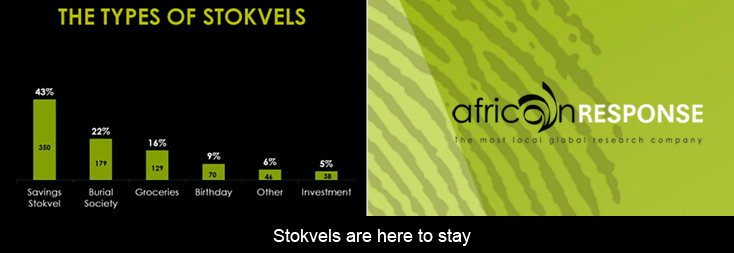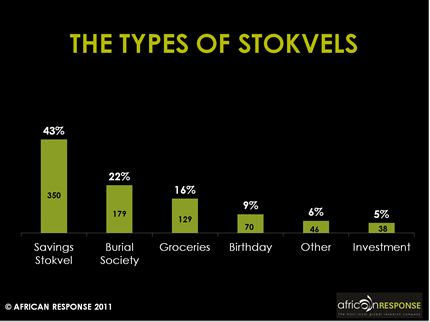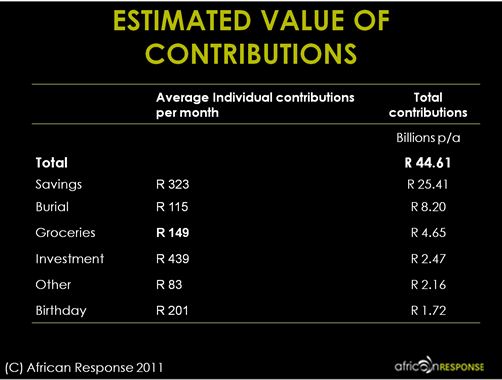Research reveals Stokvels are here to stay in South Africa
BRYANSTON – A groundbreaking survey launched last week by the most local global research company, African Response, has blown the lid off the lucrative and influential stokvel market. According to AMPS 2011, 40% of the South African population currently belong to a Stokvel.
“Given this potential, African Response sought to quantify this market in terms of size and value as well as shed some light on attitudes and behaviours. To this end, we conducted a nationwide survey with over 2 000 stokvel members” states Mamapudi Nkgadima, Managing Director of African Response.
Stokvels are defined as group savings schemes providing for both mutual financial assistance as well as social and entertainment needs.
The study revealed that there are 811 830 stokvels and 11.4 million stokvel members with a total estimated value of R44 billion in South Africa. Nkgadima states ” To put this in perspective, the population of a city made up of all the Stokvel members would be larger than any of our major metros, including Johannesburg, Pretoria, Cape Town and Durban. The value of the stokvel market would create a bigger sector in South Africa than the agriculture or electricity sectors.”
The many types of Stokvels
The most popular types of stokvels across all respondents are savings stokvels and burial societies (with 47% and 41% of those surveyed reporting membership at these stokvel types).
“Stokvel membership very much depends on individual needs, which is why there are different types” states Nkgadima. “Grocery stokvels speak to a basic physiological need while birthday stokvels fulfil social needs and saving stokvels are joined for security needs.”
Grocery Stokvels capture 20% of the total stokvel membership. 64% of grocery stokvels make bulk purchases from various retailers and wholesalers once a year – in quarter 4. “It’s important to realise that although the majority of purchasing occurs at the end of the year, a significant amount of purchasing is happening throughout the year too. Stokvels not only carry a lot of purchasing potential but the potential to influence other members and other stokvels to become a regular loyal customer to preferred retail outlets” continues Nkgadima.
Grocery purchases comprise staples, tinned goods, some meat, cooking products, cleaning agents, and personal care products. “Key purchase drivers across the various categories are based on the current brand used and trusted by the stokvel member as pricing and product drivers.
Investment stokvels make up 5% of the total stokvel market. “The rise of investment stokvels speaks to a newer aspirational need for stokvels,” explains Nkgadima. “Stokvels are no longer the domain of people in need of a collective pot for burials and groceries but provide a medium for which to learn about and jointly invest money with the aim of creating wealth and security for its members.”
The average number of members per stokvel amounts to 27. “This varies a good deal depending on what type of stokvel it is,” explains Nkgadima. “Burial Societies tend to gather much higher membership numbers while investment and birthday stokvels are closer, more intimate friendship groups.”
All across South Africa
Geographically, the province with highest penetration of stokvels is Gauteng (24%), closely followed by Limpopo (20%). Together with North West (12%) and KwaZulu Natal (14%), these four provinces make up 70% of the stokvel market. Gauteng shows an extremely high incidence of investment stokvels (56%), followed by savings (22%), burial society (27%) and birthday stokvels (22%).
The stokvel market comprises more women than men (57% and 43% respectively) at an overall level. Investment surveys are an exception and are made up of more men than women (52% male; 48% female).
Quick facts about stokvel demographics:
- Birthday stokvels are made up mostly of younger members. 66% fall into the 16 – 34 year age category.
- Saving stokvels are mostly comprised of urban members (80% urban)
- Grocery stokvels are 86% female and only 14% male
- The most popular type of stokvel amongst higher LSMs are investment stokvels – 30% of members fall into LSMS 9 – 10.
Law and Order
African Response’s survey reveals that 45% of money / savings stokvels come with a strict constitution and formalised structure. Meetings occur at least once a month and are most commonly held in members’ homes. Depending on membership size and purpose of the stokvel, these could also be held at restaurants or outside in a park or similar venue. Meetings are the most common form of communication. Telephone, email and sms are used to organise the meetings and communicate any pre-meeting information.
Money matters
The average stokvel member contributes R210 per month. Burial societies have a lower than average contribution of approximately R115 per month, whereas investment stokvels generate much higher contributions – from between R300 and R500.
“Because of the high levels of membership, non-burial groups and savings stokvels yield the highest value of contributions over a yearly period,” Nkgadima states.
Most stokvels (66%) have a stokvel bank account where contributions are deposited and saved. Birthday stokvels display a different trend, where contributions are either distributed to members of the stokvel, kept by the treasurer or put towards a specific objective such as buying a birthday gift.
Although the majority make use of a stokvel account with a financial institution, 34% of stokvels still do not, and money is managed, loaned out and allocated by stokvel members themselves. “Herein lies a great opportunity for financial services to manage stokvel finances” explains Nkgadima.
Stokvel members are you and me.
“Stokvel members are home owners, business owners, church members and people you work with,” concludes Nkgadima. “Stokvels continue to pervade all levels of society and they are here to stay. Countless opportunities exist for brands and businesses to leverage the opportunity this market presents.”
In 2012 African Response will be introducing its Stokvel Response panel using a database of Stokvel members as well as an Stokvel Omni for continuous dialogue with this segment of the market. Please contact mamapudin@africanresponse.co.za for more information in this regard. Full results from this survey are available for purchase from African Response.
About The Survey
African Response conducted our Stokvel survey in the months of August and September 2011. 2000 face-to-face interviews were conducted with over 2 000 stokvel members nationwide.
About African Response
African Response is a full-service market research company providing qualitative and quantitative research. We have the flexibility to conduct research anywhere in country with a regional springboard into the rest of Africa. We are renowned for generating local consumer and market insights to help grow brands and businesses in South Africa. Our exceptional ability to understand and interpret the needs of the South African mainstream market, coupled with our association with Synovate [one of the big 4 custom research firms globally], makes African Response the most local global research company in South Africa.
More information can be found at www.africanresponse.co.za






